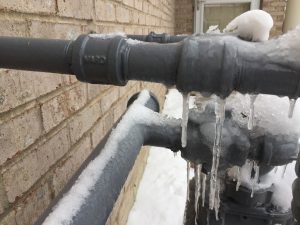Important Tips to Avoid Frozen Pipes in Winter
Important Tips to Avoid Frozen Pipes in Winter
Blog Article
We have stumbled upon this article about Preventing and dealing with frozen pipes below on the net and concluded it made perfect sense to talk about it with you over here.

Winter can damage your pipes, particularly by freezing pipes. Here's exactly how to avoid it from taking place and what to do if it does.
Introduction
As temperatures decrease, the risk of frozen pipes increases, possibly leading to pricey fixings and water damages. Recognizing how to stop icy pipes is essential for property owners in cold environments.
Prevention Tips
Shielding prone pipes
Cover pipelines in insulation sleeves or make use of heat tape to secure them from freezing temperature levels. Focus on pipes in unheated or external areas of the home.
Heating strategies
Keep interior spaces appropriately heated, especially areas with pipes. Open up cabinet doors to allow warm air to circulate around pipes under sinks.
Just how to identify frozen pipes
Look for decreased water flow from faucets, uncommon smells or sounds from pipelines, and noticeable frost on revealed pipes.
Long-Term Solutions
Structural adjustments
Take into consideration rerouting pipelines away from outside wall surfaces or unheated areas. Include additional insulation to attics, cellars, and crawl spaces.
Upgrading insulation
Invest in premium insulation for pipes, attic rooms, and walls. Correct insulation assists keep constant temperatures and reduces the threat of frozen pipelines.
Shielding Exterior Pipes
Yard tubes and outside faucets
Disconnect and drain pipes garden tubes before winter season. Mount frost-proof spigots or cover exterior faucets with shielded caps.
Comprehending Icy Pipelines
What causes pipes to ice up?
Pipelines freeze when subjected to temperature levels below 32 ° F (0 ° C) for prolonged durations. As water inside the pipelines freezes, it expands, taxing the pipeline wall surfaces and possibly causing them to burst.
Risks and damages
Frozen pipes can result in water system interruptions, building damages, and pricey fixings. Ruptured pipes can flood homes and cause extensive architectural damages.
Indications of Frozen Pipeline
Identifying frozen pipelines early can stop them from breaking.
What to Do If Your Pipes Freeze
Immediate actions to take
If you believe icy pipes, keep taps available to alleviate stress as the ice melts. Make use of a hairdryer or towels taken in warm water to thaw pipes gradually.
Conclusion
Protecting against frozen pipelines needs aggressive steps and fast reactions. By recognizing the causes, indicators, and preventive measures, homeowners can secure their pipes during winter.
5 Ways to Prevent Frozen Pipes
Drain Outdoor Faucets and Disconnect Hoses
First, close the shut-off valve that controls the flow of water in the pipe to your outdoor faucet. Then, head outside to disconnect and drain your hose and open the outdoor faucet to allow the water to completely drain out of the line. Turn off the faucet when done. Finally, head back to the shut-off valve and drain the remaining water inside the pipe into a bucket or container. Additionally, if you have a home irrigation system, you should consider hiring an expert to clear the system of water each year.
Insulate Pipes
One of the best and most cost-effective methods for preventing frozen water pipes is to wrap your pipes with insulation. This is especially important for areas in your home that aren’t exposed to heat, such as an attic. We suggest using foam sleeves, which can typically be found at your local hardware store.
Keep Heat Running at 65
Your pipes are located inside your walls, and the temperature there is much colder than the rest of the house. To prevent your pipes from freezing, The Insurance Information Institute suggests that you keep your home heated to at least 65 degrees, even when traveling. You may want to invest in smart devices that can keep an eye on the temperature in your home while you’re away.
Leave Water Dripping
Moving water — even a small trickle — can prevent ice from forming inside your pipes. When freezing temps are imminent, start a drip of water from all faucets that serve exposed pipes. Leaving a few faucets running will also help relieve pressure inside the pipes and help prevent a rupture if the water inside freezes.
Open Cupboard Doors
Warm your kitchen and bathroom pipes by opening cupboards and vanities. You should also leave your interior doors ajar to help warm air circulate evenly throughout your home.

I am very inquisitive about Prevent Frozen Pipes and I am praying you enjoyed reading the page. For those who liked our blog post if you please don't forget to share it. Kudos for your time. Kindly stop by our website back soon.
Call Today Report this page